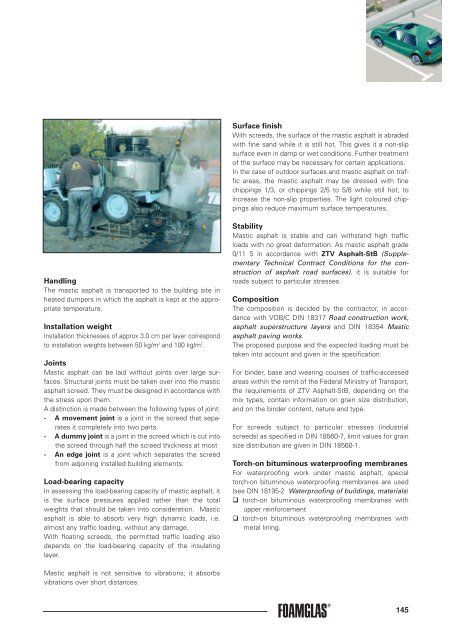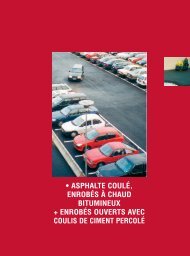mastic asphalt, asphalt hot mix + grouting asphalt pavements
mastic asphalt, asphalt hot mix + grouting asphalt pavements
mastic asphalt, asphalt hot mix + grouting asphalt pavements
Create successful ePaper yourself
Turn your PDF publications into a flip-book with our unique Google optimized e-Paper software.
Handling<br />
The <strong>mastic</strong> <strong>asphalt</strong> is transported to the building site in<br />
heated dumpers in which the <strong>asphalt</strong> is kept at the appropriate<br />
temperature.<br />
Installation weight<br />
Installation thicknesses of approx 3.0 cm per layer correspond<br />
to installation weights between 50 kg/m 2 and 100 kg/m 2 .<br />
Joints<br />
Mastic <strong>asphalt</strong> can be laid without joints over large surfaces.<br />
Structural joints must be taken over into the <strong>mastic</strong><br />
<strong>asphalt</strong> screed. They must be designed in accordance with<br />
the stress upon them.<br />
A distinction is made between the following types of joint:<br />
- A movement joint is a joint in the screed that separates<br />
it completely into two parts.<br />
- A dummy joint is a joint in the screed which is cut into<br />
the screed through half the screed thickness at most<br />
- An edge joint is a joint which separates the screed<br />
from adjoining installed building elements.<br />
Load-bearing capacity<br />
In assessing the load-bearing capacity of <strong>mastic</strong> <strong>asphalt</strong>, it<br />
is the surface pressures applied rather than the total<br />
weights that should be taken into consideration. Mastic<br />
<strong>asphalt</strong> is able to absorb very high dynamic loads, i.e.<br />
almost any traffic loading, without any damage.<br />
With floating screeds, the permitted traffic loading also<br />
depends on the load-bearing capacity of the insulating<br />
layer.<br />
Mastic <strong>asphalt</strong> is not sensitive to vibrations; it absorbs<br />
vibrations over short distances.<br />
Surface finish<br />
With screeds, the surface of the <strong>mastic</strong> <strong>asphalt</strong> is abraded<br />
with fine sand while it is still <strong>hot</strong>. This gives it a non-slip<br />
surface even in damp or wet conditions. Further treatment<br />
of the surface may be necessary for certain applications.<br />
In the case of outdoor surfaces and <strong>mastic</strong> <strong>asphalt</strong> on traffic<br />
areas, the <strong>mastic</strong> <strong>asphalt</strong> may be dressed with fine<br />
chippings 1/3, or chippings 2/5 to 5/8 while still <strong>hot</strong>, to<br />
increase the non-slip properties. The light coloured chippings<br />
also reduce maximum surface temperatures.<br />
Stability<br />
Mastic <strong>asphalt</strong> is stable and can withstand high traffic<br />
loads with no great deformation. As <strong>mastic</strong> <strong>asphalt</strong> grade<br />
0/11 S in accordance with ZTV Asphalt-StB (Supplementary<br />
Technical Contract Conditions for the construction<br />
of <strong>asphalt</strong> road surfaces), it is suitable for<br />
roads subject to particular stresses.<br />
Composition<br />
The composition is decided by the contractor, in accordance<br />
with VOB/C DIN 18317 Road construction work,<br />
<strong>asphalt</strong> superstructure layers and DIN 18354 Mastic<br />
<strong>asphalt</strong> paving works.<br />
The proposed purpose and the expected loading must be<br />
taken into account and given in the specification.<br />
For binder, base and wearing courses of traffic-accessed<br />
areas within the remit of the Federal Ministry of Transport,<br />
the requirements of ZTV Asphalt-StB, depending on the<br />
<strong>mix</strong> types, contain information on grain size distribution,<br />
and on the binder content, nature and type.<br />
For screeds subject to particular stresses (industrial<br />
screeds) as specified in DIN 18560-7, limit values for grain<br />
size distribution are given in DIN 18560-1.<br />
Torch-on bituminous waterproofing membranes<br />
For waterproofing work under <strong>mastic</strong> <strong>asphalt</strong>, special<br />
torch-on bituminous waterproofing membranes are used<br />
(see DIN 18195-2 Waterproofing of buildings, materials)<br />
torch-on bituminous waterproofing membranes with<br />
upper reinforcement<br />
torch-on bituminous waterproofing membranes with<br />
metal lining.<br />
FOAMGLAS ®<br />
145





